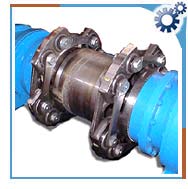 A gear coupling is a power transmission coupling which uses a hub with
gear teeth on the outside diameter of the input shaft. Like hub on the
output shaft is connected by a flange or a sleeve with teeth on the
inside diameter, to transmit torque and to accommodate shaft
misalignment. This coupling is usually all metal in construction does
require lubrication, is very rigid torosionally, and can transmit high
torque through relatively small packages.
A gear coupling is a power transmission coupling which uses a hub with
gear teeth on the outside diameter of the input shaft. Like hub on the
output shaft is connected by a flange or a sleeve with teeth on the
inside diameter, to transmit torque and to accommodate shaft
misalignment. This coupling is usually all metal in construction does
require lubrication, is very rigid torosionally, and can transmit high
torque through relatively small packages. A coupling comprises a clutch having an input connection to the power take off and an output for connection to power transmission input of the trailer unit. The tension in the coupling when it connects the tractor and trailer units is monitored, and the slippage of the clutch is controlled in response to the monitored tension. This is required so as to maintain the speed at which the trailer unit is driven substantially the same as the speed at which the tractor unit is driven.
Types of couplings
|
There are many methods to mount couplings on a shaft. For motors with access to the rear end of the shaft, couplings can be pressed directly onto the shaft. Another method is to secure couplings to the shaft with a setscrew. The presence of a flat on the shaft helps prevent slipping. It can also be mounted with the help of adhesives. Adhesive should be applied to the couplings and not to the shaft directly. Couplings can be pinned by drilling a cross-hole across the shaft.